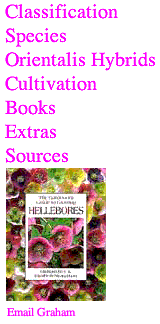

Try to sow in July, and no later than August. Although a few growers sow seed direct in the open ground, sowing in pots is altogether more dependable. The seeds need room to develop, and their young roots can be very vigorous, so use large pots; 5in/12.5cm plastic pots are ideal, and give room to space out the seeds.
Make sure the pot is clean, then fill it loosely with a soil-based seed compost such as John Innes Seed Compost or, alternatively, if you habitually use a peat- or coir-based multipurpose compost, or any other particular compost for raising perennials from seed, use that instead. Fill the pot loosely to just below the rim, tap it on the bench or table to settle the compost, and then firm gently - gently. Firming too hard will result in poor drainage and rotting seedlings. Ensure the compost is level.
The seed is sufficiently large to be sown individually; a 5in/12.5cm pot will take 21 seeds, evenly spaced. There is a lot to recommend sowing in a systematic manner: a row of five seeds evenly spaced across the middle of the pot 5; another row at right angles (nine seeds); two seeds in each space between the arms of the ‘cross’ ; finally, one seed in the middle of each ‘quarter’ . A larger pot, 61/2in/16cm will take thirty seeds.
Never use the shallow, 5in/12.5cm ‘half pots’, in which pot chrysanthemums are sometimes sold, and never use a pot smaller than 4in/10cm, even if you only have a few seeds to sow; neither provides sufficient root space. After sowing, cover the seeds with about 1/2in/12mm of grit or pea gravel. The pots are best stood on gravel or grit in a cold frame, then watered well.
A humid atmosphere encourages germination and in a summer cold frame this can be hard to create. My solution is to replace the glass light with a timber panel (actually, an old shed door) which will retain moisture around the seed pots. The seed does not need to be kept in the dark, but a humid atmosphere is certainly helpful.
An alternative is to cover each pot with an upturned terracotta plant saucer, or a plastic plant saucer kept in place with a stone. This, however, means that each cover must be removed for watering and then replaced - an irritating business.
One more thing needs to be done: the seeds must be protected from disturbance and pests, especially from the attentions of hungry mice. Individual pot coverings will do the job nicely, but failing that a covering of chicken wire to screen the pots from investigating blackbirds and cats, plus the setting of mouse traps, is necessary.
The seeds should be kept consistently moist, and the pots inspected every two or three days from October onwards for signs of germination. As soon as the first signs of germination are noticed, bring the pots into the light, remove their covers but continue to protect them from mice. Ensure also that the seedlings are protected against slugs, which can easily eat a frame full of seedlings in a single night. Fresh seed of all species should germinate by the turn of the year, sometimes as early as late October, except that of H. niger which will emerge early in the new year. Old seed, if it germinates at all, may come up at any time.
Protection from severe winter weather is advisable when the forecast indicates such precautions. Watering should continue to be consistent, and protection against mice and slugs must be vigilant.